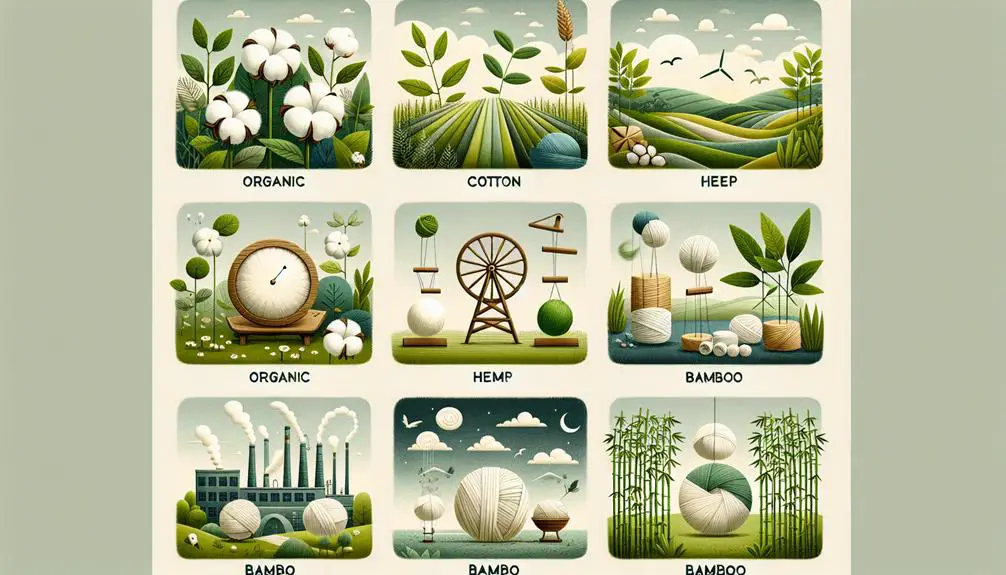Did you know that the global market for sustainable fabrics is expected to reach $95 billion by 2025? This figure underscores the growing importance of eco-friendly materials in the fashion industry. You might wonder how the higher initial costs of these fabrics can translate into long-term financial benefits. You'll find that understanding the economics of sustainable textiles involves more than just cost analysis—it's about market trends, production processes, and consumer preferences. Whether you're a designer, manufacturer, or retailer, grasping these economic factors is essential for making informed, profitable, and responsible business decisions.
Table of Contents
Key Takeaways
- Sustainable fabrics involve higher production costs but offer long-term savings through superior quality and durability.
- Consumer demand for eco-friendly textiles is rising, enhancing market opportunities for sustainable fabrics.
- Regulatory incentives, including tax breaks and grants, offset initial investments in sustainable technologies.
- Innovations in sustainable materials and production processes enhance efficiency and reduce environmental impact.
- Transparent supply chains and ethical sourcing elevate brand reputation and attract environmentally conscious consumers.
Understanding Sustainable Fabrics
Understanding sustainable fabrics begins with understanding the eco-friendly materials and production methods that minimize environmental impact. You'll find that sustainable fabrics like organic cotton, hemp, and bamboo are grown with fewer pesticides and chemicals, guaranteeing less harm to ecosystems. These materials prioritize renewable resources and often produce less waste.
To truly grasp the benefits, you need to take into account the entire supply chain. From cultivation to production, each step can either enhance or diminish sustainability. For instance, traditional cotton farming consumes vast amounts of water, whereas organic cotton uses rain-fed systems, significantly reducing its environmental footprint. Similarly, bamboo grows quickly and requires minimal agricultural inputs, making it an excellent sustainable option.
When examining the supply chain, look for certifications like Global Organic Textile Standard (GOTS) or OEKO-TEX, which ensure eco-friendly practices throughout the process. These certifications ensure that from farming to processing, sustainable methods are upheld.
Cost Analysis of Eco-Friendly Materials
When you assess the cost of eco-friendly materials, you'll need to factor in the production expenses.
Compare market prices and weigh the long-term financial benefits. Understanding these factors helps you make informed decisions about sustainable options.
Let's break down each point to see how eco-friendly fabrics stack up economically.
Production Expenses Breakdown
To grasp the true cost of eco-conscious materials, let's break down the production expenses involved in creating these sustainable textiles.
First, consider the supply chain. Sustainable fabrics often require a well-monitored supply chain to guarantee ethical sourcing and minimal environmental impact. This means that every step—from raw material extraction to final product assembly—must adhere to stringent sustainability standards. Managing such a supply chain isn't cheap; it involves regular audits, certifications, and sometimes even partnerships with eco-conscious suppliers who charge a premium for their green credentials.
Next, let's talk about labor costs. The production of sustainable fabrics often relies on fair labor practices, which include paying workers a living wage and ensuring safe working conditions. While this is a step in the right direction ethically, it does increase labor costs compared to conventional fabric production, where labor can be notably cheaper due to lower wages and less strict safety standards.
These factors—supply chain management and fair labor costs—collectively contribute to the higher production expenses of eco-conscious textiles. Understanding these expenses is vital for anyone looking to master the economics of sustainable textiles. They offer a clear view of why eco-conscious options often come at a premium.
Market Price Comparison
Comparing market prices, eco-friendly materials often command higher prices than conventional fabrics due to their sustainable production processes. This price comparison reveals that sustainable fabrics, like organic cotton or recycled polyester, usually have a premium attached. The higher costs stem from eco-friendly farming practices, ethical labor wages, and the utilization of cutting-edge technologies that reduce environmental impact.
Nevertheless, it's important to understand that this price difference reflects the sustainability impact. By investing in eco-friendly materials, you're supporting market trends that prioritize environmental health and ethical standards. These trends are driven by a growing consumer demand for transparency and responsibility within the textile industry.
When evaluating cost effectiveness, you should consider both the direct and indirect benefits. While the upfront cost is higher, the superior quality and durability of sustainable fabrics often result in longer-lasting products. This means fewer replacements and, ultimately, more savings over time. Additionally, as market trends shift towards sustainability, economies of scale may eventually reduce these costs, making eco-friendly options more accessible.
In essence, the price comparison between sustainable and conventional fabrics highlights a significant, yet justifiable, cost discrepancy rooted in sustainability impact and evolving market trends.
Long-term Financial Benefits
Beyond the initial expense, eco-conscious materials often yield substantial long-term financial benefits due to their durability and reduced need for frequent replacements. When you invest in sustainable fabrics, you're making a strategic decision that goes beyond the upfront cost. These materials frequently exhibit superior quality, meaning they stand the test of time far better than their traditional counterparts. As a result, you'll find yourself replacing items less often, leading to noteworthy financial savings over the years.
Consider the concept of investment returns when evaluating eco-friendly materials. By opting for higher-quality, sustainable options, you're fundamentally setting yourself up for better returns on your investment. The initial outlay might be higher, but the longer lifespan and diminished need for maintenance or replacement translate into tangible savings. For example, a well-crafted organic cotton shirt may last several years longer than a standard one, reducing your cost per wear significantly.
Moreover, businesses that adopt sustainable practices often experience lower long-term operational costs. This efficiency further contributes to financial savings, making eco-friendly materials not just an ethical choice, but a financially savvy one as well.
Market Trends in Sustainable Textiles
You're seeing a significant shift in the textile market as rising consumer demand drives innovations in sustainable materials.
New regulations are also playing a pivotal role in shaping the industry's future.
Let's explore how these factors are influencing market trends in sustainable textiles.
Rising Consumer Demand
Why are consumers increasingly turning to sustainable textiles?
You're likely aware that today's consumers are more eco-conscious than ever. They understand that the traditional textile industry often has a detrimental impact on the environment, from water pollution to excessive waste. This awareness has fueled demand for sustainable alternatives.
You'll find that supply chains are adapting in response to this demand. Brands are now prioritizing transparency and traceability, showcasing how their materials are sourced and manufactured. This isn't just a feel-good move; it's a strategic shift to meet consumer expectations and build trust.
Marketing strategies are also evolving. Companies are leveraging social media and influencer partnerships to highlight their commitment to sustainability. They're not just selling products; they're telling stories that resonate with consumers' values. You'll notice campaigns emphasizing the environmental and social benefits of sustainable fabrics, making it clear that choosing these products is a way to contribute positively to the planet.
Innovations in Materials
Driven by technological advancements and a commitment to environmental stewardship, the market for sustainable textiles is witnessing groundbreaking innovations in materials. You're likely seeing an influx of new fabrics designed to minimize environmental impact while maintaining high performance and durability. These material innovations aren't only reshaping the textile industry but are also gaining traction among brands and consumers alike.
Recent technological advancements have led to the development of fabrics made from recycled plastics, agricultural waste, and even lab-grown cellulose. Such innovations are setting new standards for sustainability certifications, ensuring that the materials meet stringent environmental criteria.
Consider these key trends:
- Recycled Plastics: Fabrics made from post-consumer plastic waste are reducing landfill burden and conserving resources.
- Agricultural Waste: Utilizing by-products from crops like pineapple leaves or banana stems is transforming waste into valuable resources.
- Lab-grown Cellulose: Engineered cellulose offers a renewable alternative to cotton, reducing the need for water and pesticides.
Regulatory Impact Analysis
Government regulations and industry standards play a significant role in shaping the market trends in sustainable textiles. You'll find that strict environmental regulations are compelling manufacturers to adopt eco-friendly practices. These rules aren't just about compliance; they drive innovation and push for higher standards in production processes. As a result, the demand for sustainable fabrics is soaring, fueling economic growth in this sector.
By adhering to environmental regulations, companies can avoid hefty fines and enhance their market reputation. This, in turn, attracts eco-conscious consumers willing to pay a premium for sustainable products. Thus, regulatory impact analysis is essential for understanding these market dynamics. You need to stay ahead by knowing how regulations affect supply chains, production costs, and consumer behavior.
Moreover, government incentives for sustainable practices can reduce operational costs, fostering further economic growth. Tax breaks, subsidies, and grants encourage companies to invest in sustainable technologies and materials.
When you align your business strategy with these regulatory frameworks, you're not only contributing to a healthier planet but also tapping into a lucrative market. Thus, mastering the regulatory landscape is indispensable for anyone aiming to thrive in the sustainable textiles industry.
Production Processes and Efficiency
Optimizing production processes in sustainable fabric manufacturing enhances overall efficiency while minimizing environmental impact. You need to focus on aligning your methods with sustainable practices to achieve production efficiency. This means adopting innovative techniques that reduce waste and conserve resources.
By doing so, you'll not only cut costs but also contribute to environmental sustainability.
To elevate your production processes, consider the following:
- Energy-efficient machinery: Invest in technology that consumes less energy and operates more efficiently, which can notably reduce your carbon footprint.
- Water conservation techniques: Implement closed-loop systems to recycle water, ensuring minimal waste and reducing the strain on natural water sources.
- Eco-friendly raw materials: Source materials that are renewable or biodegradable, lowering the environmental impact of your supply chain.
Pricing Strategies for Green Fabrics
To effectively market green fabrics, you need to adopt pricing strategies that reflect both their sustainable value and competitive market demands. Start by clearly defining your brand positioning. Are you targeting eco-conscious consumers willing to pay a premium, or aiming for a broader market with competitive pricing? This decision will guide your entire pricing approach.
Next, consider your supply chain and distribution channels. Sustainable fabrics often incur higher production costs, so you must optimize your supply chain to minimize expenses without compromising quality. Partner with suppliers who share your sustainability ethos. Look for efficiencies in sourcing, production, and transportation to keep costs manageable.
Your marketing strategies should highlight the ecological benefits of your green fabrics. Educate consumers about the environmental impact of traditional fabrics versus your sustainable alternatives. Use storytelling to build an emotional connection, reinforcing the value of paying a bit more for eco-friendly products.
Economic Impact on Fashion Industry
Sustainable fabrics are revolutionizing the fashion industry by driving both economic growth and environmental responsibility. When you integrate sustainable fabrics into your business model, you're not just making an ethical choice—you're tapping into a growing market that values transparency and sustainability.
By focusing on eco-friendly materials, you can streamline your supply chain, reduce waste, and enhance brand loyalty.
Here's how sustainable fabrics impact the fashion industry economically:
- Reduced Production Costs: Utilizing recycled or organic materials can lower long-term costs by minimizing waste and energy use.
- Enhanced Value Proposition: Sustainable practices attract consumers willing to pay a premium, boosting your profit margins.
- Supply Chain Efficiency: By adopting a circular economy approach, you maximize resource use and minimize environmental impact.
By shifting to sustainable fabrics, you're not only meeting regulatory requirements but also positioning your brand as a leader in innovation. The circular economy model guarantees that resources are reused, reducing the need for new raw materials and lowering costs.
This approach not only supports environmental goals but also enhances your competitive edge.
Incorporating sustainable fabrics is more than a trend; it's a strategic move that can drive long-term economic benefits and secure your place in the future of fashion.
Consumer Demand and Preferences
Why are more consumers gravitating towards sustainable fabrics in their fashion choices? As an eco-conscious consumer, you're likely aware of the substantial environmental impact that conventional fashion practices have. Sustainable fashion offers a viable alternative, appealing to those who prioritize both style and planetary health.
You might find yourself drawn to brands that emphasize ethical sourcing, ensuring that the materials used in your clothing are harvested and produced under fair labor conditions. This commitment to transparency not only enhances the quality of the garments but also supports equitable practices across the supply chain.
Another factor influencing your preference for sustainable fabrics is the growing awareness of the damage caused by synthetic materials. Microplastics and chemical pollutants from traditional textiles contribute to environmental degradation. By choosing organic cotton, bamboo, or recycled fibers, you're actively reducing this negative impact.
Moreover, as an informed consumer, you understand that sustainable fashion often offers superior durability. This means your wardrobe investments last longer, reducing the frequency of replacements and ultimately leading to a more cost-effective approach to dressing.
Profitability of Sustainable Choices
Recognizing the growing consumer demand for sustainable fabrics, businesses are discovering that eco-friendly choices can greatly enhance their profitability. By integrating sustainable practices into your operations, you're not just addressing environmental impact but also capitalizing on financial viability.
To achieve this, focus on:
- Cost effectiveness: Sustainable materials often lead to lower long-term costs. Organic cotton, for instance, may have a higher upfront cost but notably reduces water and pesticide expenses over time.
- Brand differentiation: Adopting eco-friendly strategies can set you apart from competitors. Consumers are willing to pay a premium for products that align with their values, thereby boosting your profit margins.
- Regulatory incentives: Governments worldwide are incentivizing sustainable practices through tax breaks and grants. These financial benefits can offset initial investments in green technologies.
You're not only contributing to a healthier planet but also tapping into a market that values sustainability. Financial viability and environmental impact aren't mutually exclusive; they can be symbiotic. By understanding the economic benefits of sustainable fabrics, you position your business for long-term success.
In short, sustainable choices are more than just ethical—they're economically smart.
Frequently Asked Questions
How Do Sustainable Fabrics Impact Climate Change Mitigation Efforts?
Sustainable fabrics help mitigate climate change by reducing your carbon footprint through eco-friendly manufacturing processes. They promote resource conservation and offer significant environmental benefits, making them essential in your efforts to protect our planet.
What Certifications Should Consumers Look for in Sustainable Fabrics?
When choosing sustainable fabrics, you should look for fair trade certifications and organic certifications. Confirm the products meet transparency standards and have eco-friendly labels to guarantee they align with ethical and environmental guidelines.
Are There Any Governmental Incentives for Using Sustainable Textiles?
You'll find that government incentives for using sustainable textiles often reduce costs and positively impact the environment. Look for grants, tax credits, and subsidies that encourage eco-friendly practices in the textile industry.
How Do Sustainable Fabrics Compare in Terms of Durability?
When comparing sustainable fabrics regarding durability, you'll find a favorable longevity comparison. These materials not only last longer but also offer substantial environmental benefits, reducing waste and promoting eco-friendly choices in your wardrobe.
What Are the Leading Innovations in Sustainable Fabric Technology?
You're seeing the rise of leading innovations in sustainable fabric technology, like the circular economy approach and biodegradable options. These advancements guarantee materials are reused efficiently and break down naturally, minimizing environmental impact.
- The Use of Nonwovens in Construction and Civil Engineering - July 11, 2025
- The Use of Nonwovens in Construction and Civil Engineering - July 11, 2025
- The Use of Nonwovens in Construction and Civil Engineering - July 11, 2025




